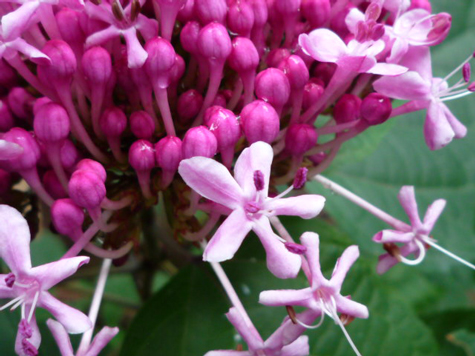Human Flower Project
Guts, Glory: Clerodendrum bungei
Some houses are haunted. Others come with stealth, showboat shrubbery.

Rose glorybower is a beauty and a curiosity
but is she a winner?
Image: Human Flower Project
Several weeks ago friends Jeannie and Jim Harbour had us out to their beautiful new place west of Austin. The previous owner had turned over the keys with one request – “Please don’t cut down those strange black sticks all over the side yard.” She knew they’d be tempted. These slightly gnarled pokers has sprung up tall, about 4 feet high, with no sign of greenery in April, but by May big heart shaped leaved had grown, and then small bud clusters appeared, weird, like little bundles of matchheads, on the top of each leafy spike.
Two weeks later Jeannie and Jim understood what the seller had been talking about. The “match tips” had each opened up into a starry pink blossom, making bloomsheads big as hydrangeas. At the Natural Gardener they learned that along with the house and pool, they’d purchased a little grove of Rose Glorybower (Clerodendrum bungei).

The blooms of Clerodendrum bungei are impressive and unforgettably scented
Photo: Jeannie Harbour
Jeannie says its other aliases are cashmere bouquet, Mexicali Rose and Mexican hydrangea (the Mexicanization of Texas mystery plants needs to be the subject of another post).
We’ve learned that Clerodendrum is derived from the Greek word kleros, meaning “chance” (dendron = tree), a reference to this plant’s iffy medicinal properties: it was thought to be “a possible cure for certain ailments.” (A delightfully modest claim, we think.)
 And does it ever grow! Here’s a South Florida specimen
And does it ever grow! Here’s a South Florida specimen
Photo: mgonline
If nothing else, rose glorybower is a cure for boredom. The transformation of its skinny black stalks into tall bushes covered with pink pompoms in the late Texas spring is awe-inspiring. Note that Clerodendrum bungei produces suckers and spreads rapidly. Invasive? Some say so, though its defenders claim the many new sprouts come up easily (pull ‘em before they get woody) or, if left alone, will create a handsome thicket in only a year or two.
Rose glorybower is also a cure for odorlessness. Allen Bush writes, “I love Clerodendrons! I don’t know if I’ve seen C. bungei but C. trichotomum has a really tell-tale peculiar smell.”
Tell-tale is right, Allen, but just WHAT tale is it telling? Romance, fable, military epic, or horror story?
We first found it honey-sweet, then citrus, then pungent – like rags that had been dipped in Lysol syrup and bleached in the sun. “Similar to jasmine” one gardener writes.
The most accurate description we’ve found thus far comes from the exacting BlueBell Nursery in South Derbyshire, U.K.. They write, “Curiously some gardeners find that the leaves smell very pleasant and similar to peanut butter, while others liken the smell to drains.”
As Jeannie would say, “Well, alright then….” Who’s ready to take a chance on Rose Glorybower?

